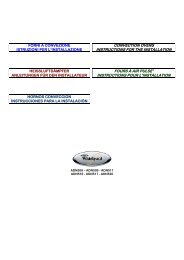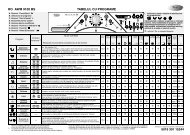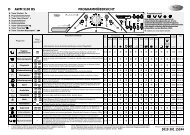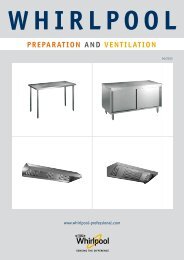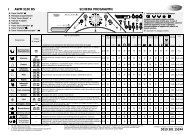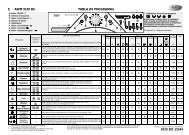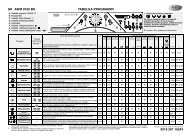INSTRUCTIONS FOR USE - Whirlpool Professional
INSTRUCTIONS FOR USE - Whirlpool Professional
INSTRUCTIONS FOR USE - Whirlpool Professional
You also want an ePaper? Increase the reach of your titles
YUMPU automatically turns print PDFs into web optimized ePapers that Google loves.
DETERGENTS AND ADDITIVESPouring in detergents and additives➡➡Pull out the detergent dispenser to its full extent.Pour in detergent:Chamber• Detergent for the pre-washChamber• Detergent for the main wash• Stain remover• Water softenerFor use of powder detergent :Push the blue slider of the divider insert to the left(picture 2); a gap remains between the divider insertand the bottom of the main wash chamber.For use of liquid detergent :Push the slider of the divider insert to the right(picture 3); the divider insert touches the bottom ofthe main wash chamber.Chamber• Fabric Softener• Liquid starchOnly add fabric softeners and conditioners up to the “Max” mark.➡Slide the detergent dispenser in until it clicks shut.Using chlorine bleach• Wash your laundry in the desired programme (Cotton,Synthetics), adding an appropriate amount of chlorinebleach to the SOFTENER chamber (close the detergentdispenser carefully).• Immediately after end of programme, start the “Rinse andSpin” programme to eliminate any residual bleach smell; ifyou want, you can add softener.12Divider insertpowder detergent -push slider to the left3Divider insertliquid detergent -push slider to the right
DRAINING RESIDUAL WATERDraining Residual WaterResidual water should be removed:• before moving a washing machine (relocation),• when installing in areas prone to frost and• before removing the filter.1.Before emptying the residual water, switch theappliance off and unplug it from the mains socket. Makesure that the water has cooled before draining.2.Turn the slot through 180° by means of a coin, so thatthe dot points to the open lock. The cover bends downto the floor.3.Remove the hose, place a low container underneath andpull the cap from the hose.4.Drain the residual water until no more flows out. Thenclose the residual water emptying hose.5.Put the hose in the cover, fold the cover up and close thecover using a coin. The dot points to the closed lock.6.Pour about 1 l of water into the detergent dispenser toreactivate the ecosystem. You must also plug the mainsplug back into the socket-outlet.7.Now you can fill the washing machine and run thedesired programme.2/535
REMOVING THE FILTERRemoving The FilterThe filter must be taken out if:• the washing machine does not drain properly,• small items, e. g. buttons and coins rattle in the pump and• 2 to 3 times a year for inspection.You must remove the residual water before taking out thefilter. Carry out the steps in the “Draining Residual Water”section, but only up to point 4. Then follow the pointsgiven below.1.Open the filter but do not withdraw it completely.Slowly turn the handle anticlockwise until the waterdrains out. Make sure that the water has cooled beforeletting it drain.2.Wait until all the water has drained out.3.Now unscrew the filter completely and extract it.4.Clean the filter and the filter chamber.5.Insert the filter with the guide pin upwards and screwit in clockwise.6.Lay the hose in the cover, fold the cover up and closeit using the detergent dispenser insert or a coin. Thedot points to the closed lock.7.Pour about 1 l of water into the detergent dispenser toreactivate the Eco System. You must also put the plugback into the socket.8.You can now load the washing machine and start thedesired programme.1566
CARE AND MAINTENANCEAppliance exterior and control panel• Clean using a neutral household detergent and adamp cloth (do not use abrasive products orsolvents).• Dry with a soft cloth.Appliance interior• If you never or seldom wash your laundry at95°C, we recommend to occasionally run a 95°Cprogramme without laundry, adding a smallamount of detergent, to keep the interior of theappliance clean.• Leave the door open for some time after eachwashing so that the interior can dry.Door seal• Clean occasionally with a damp cloth.• Check the seal folds for foreign bodiesperiodically.Filter• Check and clean the filter regularly, at least two orthree times a year (see “Removing The Filter”).Water supply hose• Check the hose regularly for brittleness and cracksand replace it if necessary using a new hose of thesame type (available from After-Sales Service orspecialist dealer).Do not use flammable fluids for cleaning the appliance.Detergent dispenserClean the dispenser drawer and the dispensercompartment regularly, at least three or four times ayear, to prevent detergent build-up.1.Press the release lever in the prewash compartment down andpull out the dispenser (see downward arrow).2.Remove the inserts from the detergent dispenser (see upwardarrows).3.Clean all parts under running water.4.Replace the separate parts in the detergent dispenser andslide the dispenser back into the dispenser compartment.Periodically check and clean the mesh filters in thewater connection.1.Turn off the tap.2.Unscrew the water inlet hose from the tap.3.Clean the internal filter.4.Screw the supply hose back onto the tap.5.Unscrew the supply hose from the washing machine.6.Clean the mesh filter in the washing machine.7.Screw the supply hose back on to the machine.8.Turn on the tap and ensure that the connections arewater-tight.
INSTALLATIONRemove the transit bolts1.Slacken the four bolts with the spanner supplied.2.Unscrew the bolt by hand.3.Grip the bolt and remove it through the large aperture.4.Seal the resulting holes using the plastic caps supplied.To do this, insert the caps in the wide part of the holein the direction of the arrow and push them into thenarrow groove until they click into place.5.Keep the transit bolts for future use.• Whenever the appliance is transported, the transit boltsmust be refitted:1.Raise the plastic covers with a screwdriver, slide themin the opposite direction of the arrow and remove.2.Insert the transit bolts in the reverse order.
Adjust the feetSmall unevennesses in the floor can be compensated forby screwing the four appliance feet up or down (never usepieces of wood, cardboard or similar material):1.The washing machine must be installed horizontally inwidth and depth. Use a spirit level.2.Loosen the locknut clockwise using the wrenchprovided.3.Adjust the height of the foot by hand.4.Tighten the locknut anti-clockwise to the washingmachine.If the appliance is to be installed on a wooden floor,distribute the weight by placing it on a 70 x 70 cm sheetof plywood at least 3 cm in thickness.Screw the plywood sheet to the floor.
Connect the water supply hose(s)• If your washing machine has one inlet hose and one inletvalve on the back: connect to cold water supply only.• If your washing machine has two inlet hoses and twoinlet valves on the back: connect to cold and hot watersupply, or to cold water supply only by using the Y-piececonnector. Both inlet valves must be connected to thewater supply. Observe the detailed instructions in yourprogramme chart.1.Carefully screw the hose connection onto the tap,preferably by hand.2.Make sure there are no kinks in the hose.3.Check water-tightness of tap and appliance connections byturning the tap completely on.The appliance must not be connected to the mixing tap of anon-pressurized water heater.The appliance can be connected without a non-return valve.If the flexible hose is damaged, unplug the appliance fromthe mains immediately.If the hose is too short, replace it with a longer length of“Water Stop” hose (available from After-Sales Service orspecialist dealer).Mount the new hose professionally on the washing machineand the tap.Note that the Aquastop/Water Stop safety function is nolonger guaranteed once the hose coating is damaged.Safety valve inspection windowConnect the water drain hose1.Connect the drain hose to the ventilated siphon or hook itover the edge of a sink with the “U” bend.2.Make sure there are no kinks in the hose.3.Secure the hose so that it cannot fall down while theappliance is running.Small wash-hand basins are unsuitable.If you need to add an extension, use a hose of the same type.Secure the connections with clips.Max. drain hose length: 2.50 mMax. drain height: 1.25 mMin. drain height: 0.70 m
ELECTRICAL CONNECTIONFor Great Britain onlyWarning - this appliance must be earthedFuse replacementIf the mains lead of this appliance is fitted with aBS 1363A 13amp fused plug, to change a fuse in this typeof plug use an A.S.T.A. approved fuse to BS 1362 type andproceed as follows:1. Remove the fuse cover (A) and fuse (B).2. Fit replacement 13A fuse into fuse cover.3. Refit both into plug.Important:The fuse cover must be refitted when changing a fuse andif the fuse cover is lost the plug must not be used until acorrect replacement is fitted.Correct replacement are identified by the colour insert orthe colour embossed in words on the base of the plug.Replacement fuse covers are available from your localelectrical store.For the Republic of Ireland onlyThe information given in respect of Great Britain willfrequently apply, but a third type of plug and socket isalso used, the 2-pin, side earth type.Socket outlet / plug (valid for both countries)If the fitted plug is not suitable for your socket outlet,Please contact After-Sales Service for further instruction.Please do not attempt to change plug yourself. Thisprocedure needs to be carried out by a qualifiedtechnician in compliance with the manufacturesinstructions and current standard safety regulations.Ecological Paper5019 301 15227 GBPrinted in Germany1/1108



